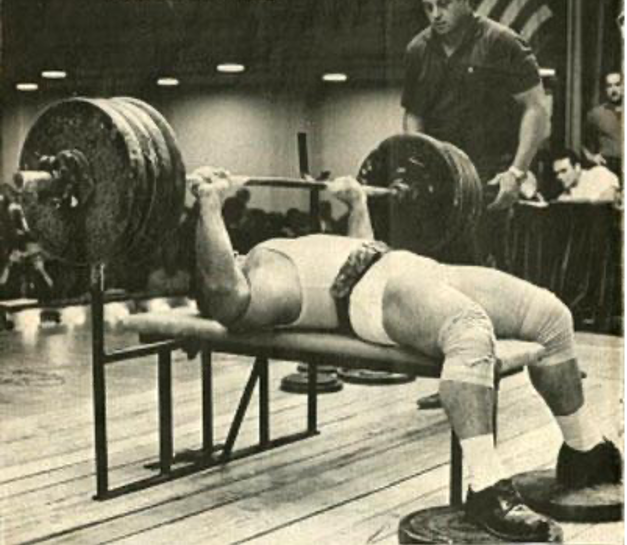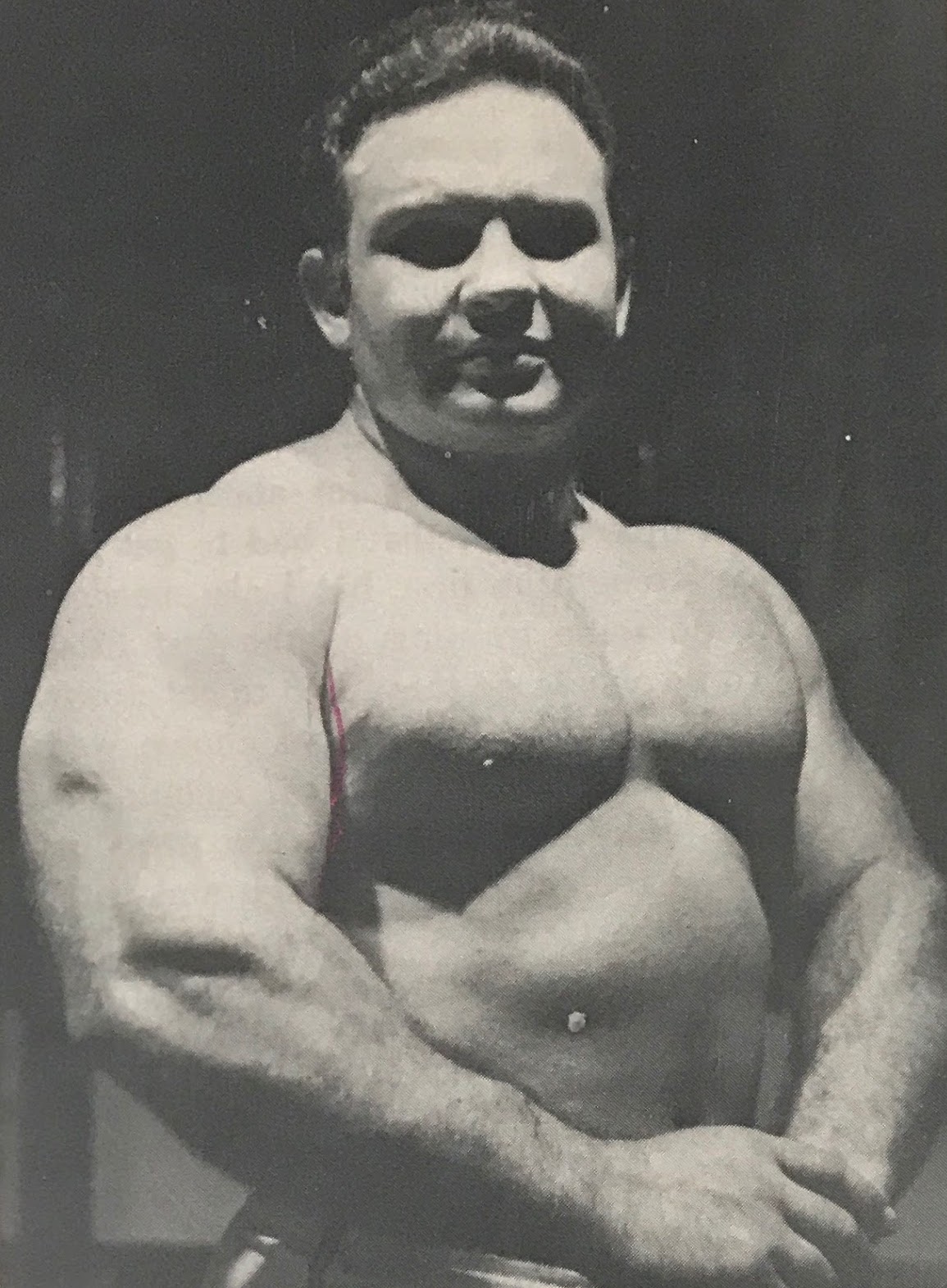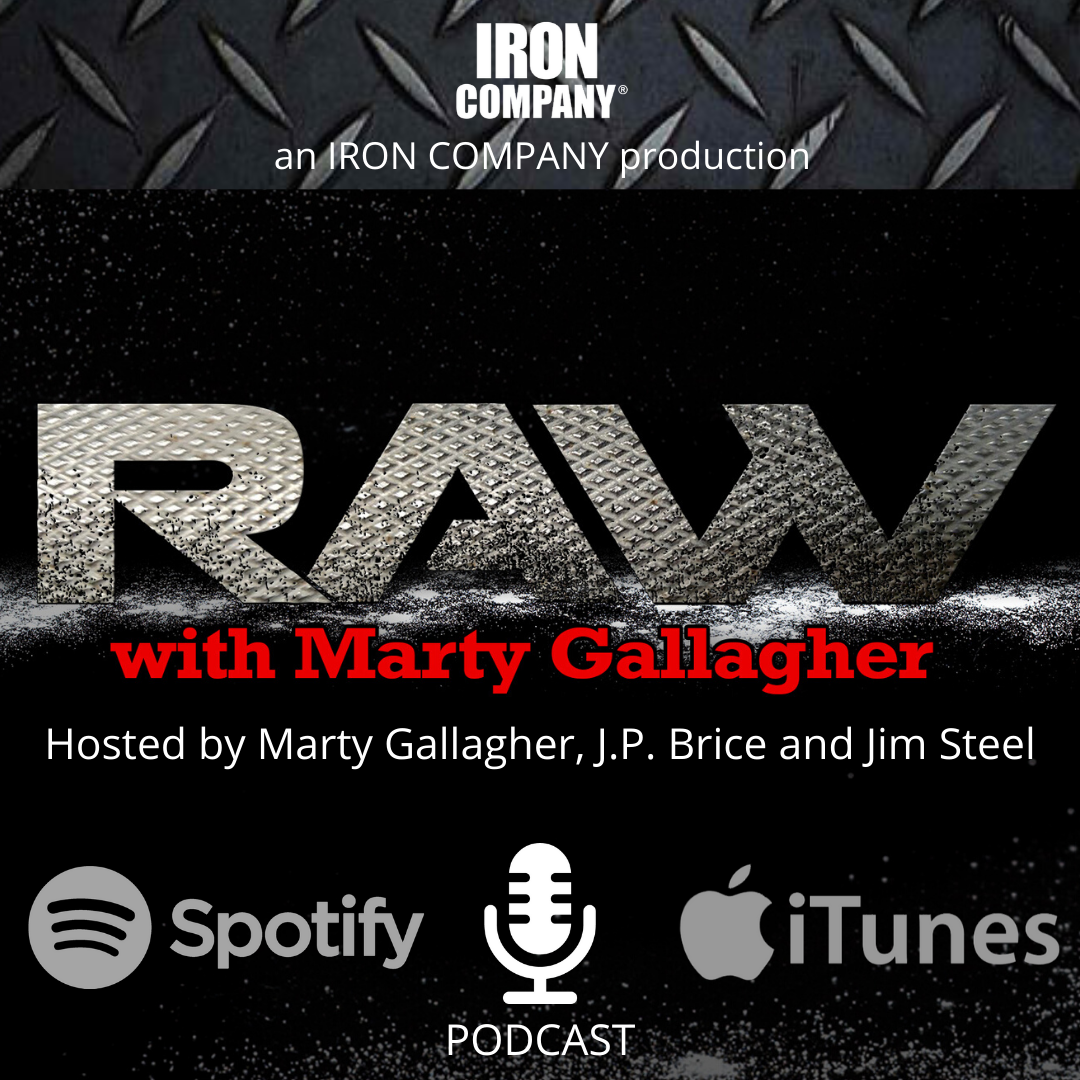
Run Up The Hill, Plant The Flag, Do It Over Again
Run up the hill, plant the flag, dial it way back, run up the hill again
What to do when progress comes to a screeching halt?
Mel Hennessey (above) used barbells and dumbbells exclusively and discovered how to continually overcome sticking points by continually adding muscle size. He stood a diminutive 5 foot 4 inches and weighed 220-rock hard pounds. Mel had bones like a mastodon. He bench-pressed 600-pounds raw using no technique. Note how he’s wearing his street shoes (and no arch or leg tension) as he casually benches 585 – this after a 2-second pause on the chest.
Last Sunday I did a top set of five reps in the ultra-deep squat with 315-pounds. This was past my realistic limit. No knee wraps, no weightlifting belt, the first three reps were hard as hell. I swore that every rep would be deep, ass-on-heels deep, and to that end I had world champion and training partner Kirk Karwoski call my depth on every rep. He would yell, “Good!” as I completed each rep.
Like I said, the first three reps were hard as balls. Yet I was “feeling my oats” as my Arkansas grandmother would say for some strange reason when I was an exuberant and precocious eleven-year old having a good day. I should have racked the weight: a triple with 315 would be a thirty-pound improvement over the previous week. Still, I was having a precocious day and I knew it – so I cast caution to the wind and went for rep #4.
It was ugly and excruciating and lasted forever and caused my form to break down. I struggled to come erect before I ran out of oxygen, I locked it out and gasped for air like someone who’d had their head held underwater. I sucked in a giant gulp of air and had the mad thought to try another rep. It was like being in a Wingsuit peering over the side of a mountaintop cliff on a pristine day high in the Alps. I decided to step off the edge.
I had confidence in my spotters. They would catch me if I collapsed. I rated my chances of success as very poor; I was 60% certain I would fail. I stood erect at the end of rep #4 chugging air in big gulps, forcing huge breaths of air down my gullet while my trembling legs tried to recover.
After sucking in four giant breaths, which took a good 15-seconds and allowed me to recover somewhat (as much as a man can with 315-pounds draped across his shoulders) my spotters were incredulous when I unlocked my knees to begin the descent on yet another rep in a set that should have ended two reps ago.
I resisted the negative portion of the rep as best I could until parallel. At that point I released my thigh muscle tension and allowed the 315 to push me to the bottom-out point. I caught the rebound and tried to hook onto upward momentum, hoping it would amplify whatever leg strength I had left. It wasn’t enough. I didn’t have enough leg strength left to push through the sticking point. It was like running into a concrete ceiling.
I hit the sticking point so hard it bent me forward. The barbell was now in front of my knees. The payload had not moved but by bending forward I enabled my legs to telescope upward, allowing my thighs to attain a better push position. My legs were on the other side of the sticking point, the rest of me was not.
I now had to lift the out-of-position 315-barbell to lockout using my spinal column as the lever. This is when vertebra explode like stepped-on landmines. I preach against this kind of stupid, arrogant, ego-stuffed, brain-dead macho lifting and would cuss out a student for doing exactly what I was doing – I would step in and stop the set – yet here I was doing it.
Luckily, because we squat using an upright style, I had another trick left: though my legs were fried, my lower back was still relatively fresh. I used my spinal column to derrick the weight to lockout. I did a “good morning” exercise with 315-pounds on the back of my neck, ratcheting the barbell upward one excruciating inch at a time, like an auto jack. It was reckless, needless, heedless, dangerous, stupid and exhilarating.

For me, the training goal is always the same: to trigger hypertrophy, muscle growth. The creation of new muscle mass always begets strength and power increases. My usual procedure on the top set of an exercise is to “rep out” the weight. I perform as many reps as I can with the top set poundage. Why not? We only squat, bench press, deadlift and overhead press one time per week. To my way of thinking – why arbitrarily quit if you got more?
My goal is, engage in a “barely completed final rep,” this the final rep of the top set. The barely completed rep is indicative of having exerted 100% or more. You have worked up to (or past) your capacity on that day and at that time. You have given it everything you have. You might have been weak, strong, normal, no matter – you repped until you don’t have another rep left. You did your progressive resistance duty.
All out effort is the kind of effort needed to induce hypertrophy and to unleash the cascade of beneficial hormones: adrenaline, endorphins, serotonin, growth hormone, norepinephrine, anandamide…The benefits of resistance training do not (fully) manifest in response to arbitrarily halted sets, 85% efforts. Partial effort results in partial results: herculean efforts result in profound results.
The good stuff (hypertrophy, strength, raw power, the hormonal floodtide) only occurs in response to training efforts that equal or exceed 100% of capacity. Capacity is a shifting target; some days we are more capable than others. Some day’s 100% is higher than other days.
I breached my capacity barrier on my 315 x 5 top set. I undoubtably unleashed the hormonal floodtide and somehow managed to not hurt, damage or injure myself – this time. This was an obvious peak. To try and exceed this effort next week would be suicidal. In six weeks, I had gone from squatting my usually 225 for 8-10 reps to 315 x 5. That rocket ride is over.
Now what?? I sure as hell was not going to try and top this next week. I had crested, peaked, shot my wad. I had tied into poundage beyond my capacity and won – barely, by the skin of my teeth. I had played with fire and escaped serious injury. I had run up the hill as far as I could and planted my flag: 315 x 5, squats done deep - but with terrible form on the final reps.
This weighing 205. It is always important to plug in bodyweight when citing lifting stats. Your feats are always in relation to your current bodyweight. This time I began the run up the squat hill with 205-pounds, my bodyweight. In week one I took the 205 and repped it out: squatting ass-on-heels until I could not do another rep. I got 12 reps.
It is important to note that each of the 12-reps was done “on the breath,” only one (massive) breath per squat allowed: no standing and huffing breaths like I did on my 315 x 5 set. Each squat gets one breath, no more. This is purposefully limiting factor that teaches a man how to really breath, properly breath, how to breath as “if trying to suck all the air out of the room.”
My periodized strategy is Simple Simon stupid. I might as well be walking a calf around in a circle until it becomes a bull – each successive week I add ten pounds to the previous week’s squat poundage and rep it out. Ass-on-heels reps, one breath per squat and NO degradation of form allowed – as soon as the first hint of technical breakdown appears, the squat set is over.
I think it would be fantastic if on this run up the hill, I could plant the flag at 345 or 355 for 3-5 perfect reps. No more banzai wing suit sets using gawd-awful technique. During this 12 to 14-week blitzkrieg, as the poundage goes up, the reps will go down. That’s why it is so important to fight like hell to keep the reps up on the front end of the periodized cycle.
My goal going into each week’s once-a-week squat session is to match whatever reps I did the previous week with the newly increased poundage. You fight, fight, fight harder to keep the reps up. Use the initial weeks and the light poundage to establish perfect technique. Use a maximum range of motion in order to dig the deepest possible muscular inroad, thereby obtaining the maximum possible strength and power results. Settle in for the long haul.
You get one crack per week at big squatting: you got to get it together mental and physically for each week’s squat session. Make it a life-or-death thing, regardless if you are feeling on top of the world or frazzled and fried, regardless, Man Up and do your duty: work up to 100% or more of that diminished or enhanced capacity. Rep something out. Make sure you have spotters.
Get used to the idea of peaks and valleys: peak, regroup, peak again. Run up the hill, plant the flag, retreat – but to a higher starting point than before. Now run up the hill again, plant the flag higher. Sisyphus-like, seemingly mindless. What they never mention is Sisyphus had a hell of a set of muscles.
About the Author
As an athlete Marty Gallagher is a national and world champion in Olympic lifting and powerlifting. He was a world champion team coach in 1991 and coached Black's Gym to five national team titles. He's also coached some of the strongest men on the planet including Kirk Karwoski when he completed his world record 1,003 lb. squat. Today he teaches the US Secret Service and Tier 1 Spec Ops on how to maximize their strength in minimal time. As a writer since 1978 he’s written for Powerlifting USA, Milo, Flex Magazine, Muscle & Fitness, Prime Fitness, Washington Post, Dragon Door and now IRON COMPANY. He’s also the author of multiple books including Purposeful Primitive, Strong Medicine, Ed Coan’s book “Coan, The Man, the Myth, the Method" and numerous others. Read the Marty Gallagher biography here.



